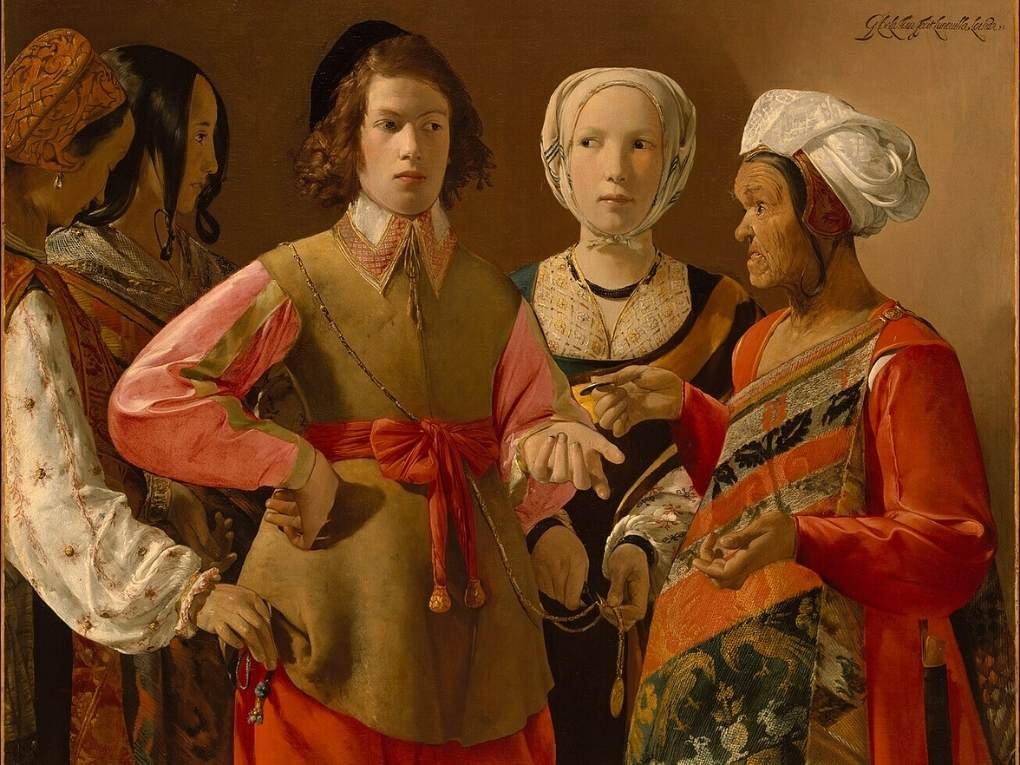New York, Metropolitan Museum of Art
This painting is full of enigmas relating to its painter, subject and provenance. Signed in Latin in its top right corner ‘G. de La Tour Fecit Luneuilla Lothar’ (made by G. de la Tour, Lunéville Lorraine), this is one of the few daylight paintings by an artist who specialised in nocturnal scenes. Little is known of him: he seems to have worked mostly for the bourgeoisie and bureaucrats of Lorraine and was successful enough to be given the title of peintre du roi (Painter to the King) in 1639. There is no record of his travels, if he made any, but his art reveals the influence of the art of Caravaggio and his followers, including Gerard Honthorst, who were fascinated with the representation of light.
The picaresque subject is also Caravaggesque: a naïve young man duped by a group of thieves. The toothless old woman seems to be haggling with the well-dressed youth over the price of something – she holds a coin, he holds his hand out. But while his suspicious gaze is fixed on her, her three young accomplices rob him. There is no indication of setting, though all wear colourful costumes. Are they in a brothel? Are the robbers gypsies? As it has a theatrical air, could it be a scene from a play, such as the parable of the prodigal son?
But la Tour does not play the scene for comedy or eroticism. Sideways glances, expressive hand gestures and a mix of shadow and crisp daylight create an atmosphere ripe with tension: what will happen next? Details are meticulously rendered; from the patterns on the colourful fabrics to the words AMOR (love) and FIDES (faith) written minutely on the young man’s watch chain. Despite the moralising theme, the artist seems to imbue each character with humanity: the foppish youth seems more naïve than dissolute and there is a sense of sadness and peril about the thieves (punishments for stealing in the 17th century included cutting off an ear, branding or death). The picture seems to warn of the dangers for all in a world of deceit and greed.
It is an exceptional work, which makes it even more surprising that la Tour was forgotten for three centuries until rediscovered by art historians in the 20th century. In 1900 only two paintings by him were known; by 1972 there were 30. This painting first surfaced in 1942. The story goes that a French prisoner of war saw a painting in a book on Georges de la Tour that reminded him of a picture in his uncle’s estate in the Loire. After the war, the painting was examined by experts and declared a la Tour. It was put on the market in 1949 and the Louvre was outbid by French art dealer Georges Wildenstein (he paid 7.5 million francs). Wildenstein did not sell the painting until 1960 when the Metropolitan Museum purchased it for an undisclosed, but ‘very high sum.’ At the time the French Government was furious, as it was unclear how an export license for a French art work was obtained.
None of this is that unusual in the unsettled art market after World War II; however in 1984 an art historian named Christopher Wright published a book claiming that this painting and all of la Tour’s pictures set in daylight were forgeries. Wright, who as a young scholar had been involved in la Tour authentications, said that he had been pressured to pronounce the work genuine by powerful figures such as Sir Anthony Blunt, the famed art expert/spy. Wright even suggested that a French restorer (who died in 1954) named Delobre who worked for Wildenstein in the USA had painted them. Many have dismissed Wright’s claims, including the Met, but an aura of mystery remains.
Contemporary Works
1633 Anthony van Dyck: Queen Henrietta Maria with Sir Jeffrey Hudson and a Monkey, Washington, National Gallery of Art
1634 Rembrandt: Saskia as Flora, St Petersburg, Hermitage
1634–5 Diego Velázquez: The Surrender of Breda, Madrid, Museo Nacional del Prado
Categories:
- Baroque
- Caravaggism
- Genre
- tenebrism

